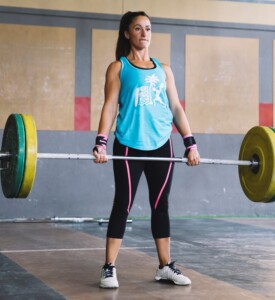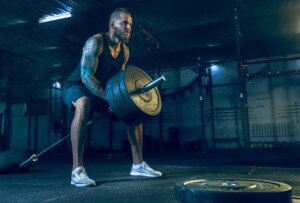Did you crush it at the gym with your back workout, only to be ravenously hungry the next day?
And here’s the thing: You eat a TON and are still hungry!
For those working on caloric surplus to pack on muscle, the hunger the day after a back workout is welcome for those who have trouble eating enough food to gain lean mass.
However, for those wanting to lose body fat, that extra hunger can present a problem.
First of all, if you’re blazing hungry in the hours following or the day after a back workout, this means you kicked butt. Pat yourself on the back!
The relentless hunger is telling you to reward your hardworking muscles so that they can adequately repair themselves.
Intense hunger the day after a back workout — in a body that otherwise feels great (save for normal soreness) — does NOT mean there’s anything abnormal about the way your body works.
It’s a natural response. But keep in mind that it can also be a sign that you’re not fueling your body enough prior to your back regimen, and possibly not hydrating adequately nor eating effectively enough in the hours and day following.
Why You’re So Hungry After Back Day
When someone experiences this, their routine usually consists of at least four of the following exercises:
• Deadlift
• Dumbbell bent-over row
• Lat pull-down
• Pull-up/chin-up
• Seated row
• T-bar row

Freepik.com
“Back weightlifting exercises work out some of the largest muscles of the body – muscles of the back,” says Natasha Fuksina, MD, an internal medicine and obesity specialist who combines traditional, integrative and functional medicine to restore health and function.
“Deadlift involves erector spinae, rhomboids and leg muscles: hamstrings, quads.”
The entire posterior chain gets kicked by intense deadlifts. Shoulder and arm muscles as well are recruited.
“Dumbbell row – uses latissimus dorsi, the largest muscle of the back,” continues Dr. Fuksina.
“During a pull-down you are using latissimus dorsi and some of the rhomboids.” Same with pull-ups.
“Seated row works all back muscles, but mostly latissimus and rhomboids.”
The T-bar row may also involve the legs.

Shutterstock/Master1305
“These exercises require a lot of energy expenditure and increased work of breathing during the exercise,” says Dr. Fuksina.
Which requires – and burns – more fuel during work? A small car or an 18-wheeler truck?
Think of the back muscles as 18-wheelers. When the leg muscles are brought into the mix, the energy expenditure is amplified.
“Such exercises increase muscles’ demand for amino acids, which are the building blocks for the muscle, which are ultimately used to build the muscle with exercise (muscle hypertrophy).
“In the several hours after the exercise the body uses the available energy supplies which it mobilizes from muscle itself [glycogen stores], liver and adipose [fat] tissue.
“However, as those are depleted, a hunger signal is sent to a person’s brain to increase one’s intake of food to help meet the demand of recently worked-out muscles of the back.”
You slaughtered it on back day; your muscles are crying for recovery fuel: food.
How not to Be So Hungry After Back Day
You don’t want to par back on the intensity of your routine. Keep killing it. The solutions are to change how you’re feeding your body.
#1 Some people thrive on working out first thing in the morning on an empty stomach. This may relate to the goal of losing body fat, but it may also be a matter of comfort.

Shutterstock/martvisionlk
If exercising with food in your stomach makes you feel weighed down or bloated, then continue working out on your morning empty stomach as long as you don’t feel faint or lightheaded.
But…you must make sure you’re adequately hydrated prior to, during and after the workout.
If your workout exceeds 90 minutes, you should take a protein/carb break about an hour in.
That all said, some people may want to eat a small meal prior to their morning workout.
#2 Even if you eat before the workout, if it’s a long session you should have some protein and carbs about an hour in.
#3 Ideally, you’ll want to have a hearty protein and carb meal within 30 minutes of completing your hefty workout.
If that’s not possible, aim for an hour. If you had a protein/carb break an hour into your routine, then you can refuel two hours later.
#4 To prevent unremitting hunger, you may have to eat another protein/carb meal two hours after your post-workout meal. And then a meal two to three hours after that.

This may sound like too much for someone trying to lose fat, or not doable for those who work out in the evening and don’t like to eat meals close to bedtime.
But the meals need not be big. They just need to be quality sources of protein and carbs.
#5 If your hunger is raging the day after the back workout, don’t go more than two hours without food.
This doesn’t mean have an actual meal every two hours. But half a cup of almonds or cashews, for instance, may suppress your hunger.
Or toss in an extra protein shake, or chicken breast, lamb patty, banana with peanut butter, fruit smoothie, dish of rice, tuna salad, canned salmon with steamed carrots, potato with steamed broccoli, etc.
And keep plenty hydrated. Remind yourself that the hunger you feel after your back regimen is a sign of hard fruitful work!
 Dr. Fuksina is the founder of astraMDhealth, which includes telemedicine. Double board certified in internal and obesity medicine, she focuses on a personalized approach, including metabolism and genetic makeup, to customize treatments and preventive care.
Dr. Fuksina is the founder of astraMDhealth, which includes telemedicine. Double board certified in internal and obesity medicine, she focuses on a personalized approach, including metabolism and genetic makeup, to customize treatments and preventive care.
 Lorra Garrick has been covering medical, fitness and cybersecurity topics for many years, having written thousands of articles for print magazines and websites, including as a ghostwriter. She’s also a former ACE-certified personal trainer.
Lorra Garrick has been covering medical, fitness and cybersecurity topics for many years, having written thousands of articles for print magazines and websites, including as a ghostwriter. She’s also a former ACE-certified personal trainer.
.



























